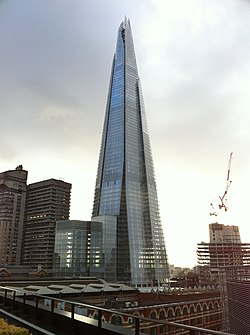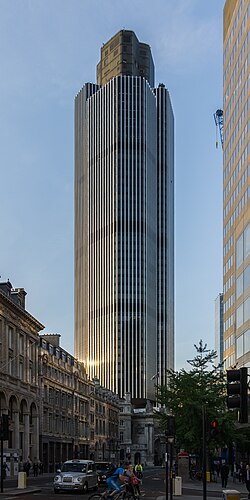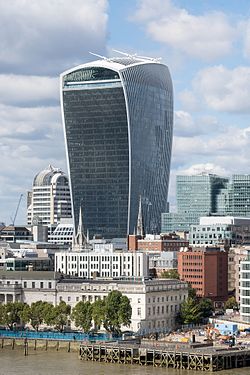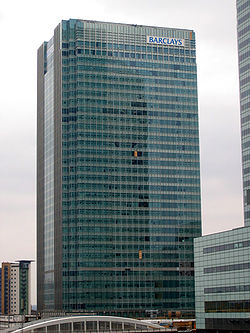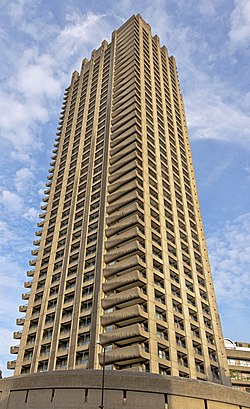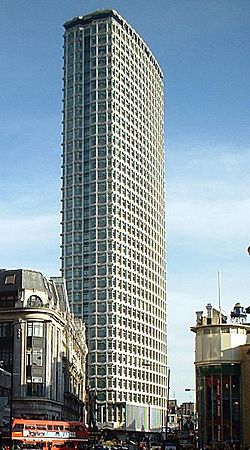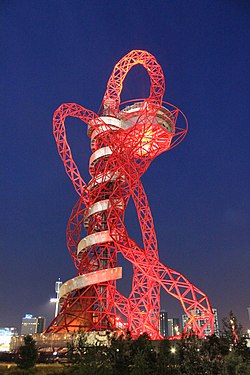Top Qs
Timeline
Chat
Perspective
List of tallest buildings and structures in London
From Wikipedia, the free encyclopedia
Remove ads
London, the capital and largest city of the United Kingdom, has 128 completed buildings that are at least 100 metres (328 feet) tall as of 2025, 42 of which have a height greater than 150 metres (492 ft).[1] London has one of the largest skylines in Europe; it has the most skyscrapers taller than 150 m (492 ft) in the United Kingdom and in Western Europe, and the third most of any city in Europe overall, after Moscow and Istanbul. London's skyline has undergone immense transformation in the early 21st century. Since 2013, the tallest building in London and the United Kingdom has been The Shard, the only supertall skyscraper. The pyramid-shaped building in Southwark rises to a height of 306 m (1,004 ft).[2] London has two primary skyscraper clusters: the City of London in central London, and Canary Wharf with the Isle of Dogs in East London, alongside numerous smaller groupings throughout Greater London.

For two centuries since 1710, St Paul's Cathedral was the tallest structure in London. While early skyscrapers sprouted in the late 19th and early 20th century in the United States, London—then the world's largest city—avoided this trend. In 1894, after work on the 12-storey Queen Anne’s Mansions, the London Building Act imposed a height limit of 30 m (98 ft) or less across the city.[3][4][5] This restriction was lifted in the 1950s,[6] permitting the construction of high-rises taller than St. Paul's. The destruction during The Blitz allowed more room for modern development.[7] Early skyscrapers were built on the west side of central London, most notably the BT Tower in Fitzrovia in 1965. A concentration of tall buildings arose in the City of London, including office towers such as St Helen's and Tower 42, and Barbican Estate, a three-towered residential complex that is a prominent example of brutalism. The London Docklands in the Isle of Dogs, which had become disused in the 1960s, underwent a significant redevelopment plan in the 1980s, resulting in the financial district of Canary Wharf. Among the first skyscrapers built there was One Canada Square in 1991. At 236 m (774 ft), it surpassed Tower 42 to be London's tallest building; it is currently the city's third-tallest building and still the tallest in Canary Wharf.

Since the 2000s, London has been experiencing a substantial skyscraper boom, which has accelerated in the late 2010s. This initially took place mostly in the City of London and Canary Wharf. The Gherkin, completed in 2004 in the City, is a recognised example of contemporary architecture. Further office skyscrapers in the City of London, such as 20 Fenchurch Street and 122 Leadenhall Street, have been given nicknames due to their distinctive shapes. The City of London's tallest building, 22 Bishopsgate, initially broke ground under the name The Pinnacle in 2008, but construction was halted in 2012. After a redesign, which removed the proposed curved-glass roof,[8] it was completed in 2020. Numerous skyscrapers are planned for the City, including 1 Undershaft, which would be the tallest in the district, owing to high demand for grade-A office space.[9][10] Canary Wharf has seen a major influx in residential skyscrapers since the 2010s, with the Wood Wharf neighbourhood expanding the skyscraper cluster eastwards.

High-rises have increasingly proliferated across London since the 2010s, particularly in the areas of Vauxhall/Nine Elms, Elephant and Castle, and Stratford. The tallest buildings in each area (One Nine Elms City Tower, Highpoint, and Manhattan Loft Gardens respectively) have been built since 2018. This has been associated with residential regeneration efforts; in Stratford, development was spurred by the 2012 Summer Olympics. The New London Vernacular has influenced the design of these new towers. In the late 2010s and 2020s, this has extended to more areas across inner and outer London, most notably in Lewisham, Croydon, North Acton, and Wembley Park. One Blackfriars, completed in 2019 in the South Bank, will be accompanied by skyscrapers in the Bankside Yards project. Considerable residential high-rise development has also occurred in Barking, Blackwall, Canada Water, Canning Town, Greenwich Peninsula, Paddington, Poplar, Shoreditch, Silvertown, Southwark, Wandsworth, White City, and along City Road.
Remove ads
History
Summarize
Perspective
Number of high-rise buildings in London by the end of each year, based on the information in this article. This includes topped-out and under construction buildings expected to be completed in 2025. Non-building structures are excluded. Click on the legend to toggle a specific height on or off. View chart definition.
Medieval and early modern period
The history of tall structures in London began with the completion of the 27-metre (89 ft) White Tower, a part of the Tower of London, in 1098.[11] The first structure to surpass a height of 100 metres (328 ft) was the Old St Paul's Cathedral. Completed in 1310, it stood at a height of 150 metres (492 ft).[11] St Paul's was the world's tallest structure until 1311, when its height was surpassed by Lincoln Cathedral in Lincoln.[12][13] It regained the title when the spire of Lincoln Cathedral fell in 1549.[13][14][15]
Although the spire of the Old St Paul's was destroyed by lightning in 1561, it still stood as the tallest structure in London,[15] while the world's tallest structure became Strasbourg Cathedral in Strasbourg, France.[16][17][self-published source?] St Paul's was severely damaged by the Great Fire of London in 1666.[18] The title of the tallest structure in London passed to Southwark Cathedral, which stands at a height of 50 metres (164 ft) and no structure in London again rose above 100 metres until 1710, when the current St Paul's Cathedral was completed at 111 metres (364 ft), becoming London's tallest building.[19][11]
Late 1800s
Few skyscrapers were built in London before the late 20th century, owing to restrictions on building heights originally imposed by the London Building Act 1894 (57 & 58 Vict. c. ccxiii), which followed the construction of the 14-storey Queen Anne's Mansions.[20] Though restrictions have long since been eased, harsh regulations remain to preserve protected views, especially those of St Paul's, the Tower of London and Palace of Westminster, as well as to comply with the requirements of the Civil Aviation Authority.[21][22]
1960s and 1970s
The lifting of height restrictions caused a boom in the construction of tall buildings during the 1960s.[22][23] St Paul's Cathedral remained as London's tallest building until it was overtaken in 1963 by the Millbank Tower at 118 metres (387 ft),[11][24][25] which in turn was overtaken by the BT Tower which topped out just one year later in 1964 at 177 metres (581 ft) and officially opened in 1965 (then known as the Post Office Tower).[11][26][27][28] One of London's first notable tall buildings was the 117-metre (384 ft) Centre Point, completed in 1966.[29]
Others completed in the 1960s include: the Empress State Building at 100 metres (328 ft) in 1961,[24][30] the Shell Centre at 107 metres (351 ft) in 1961,[31][32] the London Hilton at 101 metres (331 ft) in 1963,[33][34] Portland House at 101 metres (331 ft) in 1963,[31][35] and Euston Tower at 124 metres (407 ft) in 1970,[24][36] all built on the west side of Central London. In 1969, St. Helen's at 118 metres (387 ft) was completed in the City of London,[24][37] along with Britannic House in 1967 at 122 metres (400 ft),[38][39] but the latter was refurbished in 2000, increased to 127 m in height and renamed Citypoint.[40] Cromwell Tower, completed in 1973, Lauderdale Tower, completed in 1974 and Shakespeare Tower, completed in 1976, all at 123 metres (404 ft), were built as part of the Barbican Estate in the northern part of the City of London.[41][42][43]
1980s, 1990s and 2000s
The NatWest Tower, later renamed Tower 42, was completed in 1980, which at 183 metres (600 ft) and 42 storeys, was considered the first "skyscraper" in the City of London.[44] Its height was controversial, being contrary to the previous height restrictions, it was the tallest building in the United Kingdom at the time and also the tallest cantilever building in the world.[44] Following an over ten-year gap, One Canada Square was completed in 1991 at 235 metres (771 ft) and formed the centrepiece of the Canary Wharf development,[44] which itself is part of the Isle of Dogs and can be considered the east-side of Central London. At 50 storeys, it became the tallest building in the United Kingdom.[44]
With the encouragement of Ken Livingstone who was Mayor of London from 2000 to 2008, a renewed trend for building tall was established in the 2000s.[45][46][47]
Following another over 10-year gap, 8 Canada Square and 25 Canada Square, both standing at 200 metres (660 ft), were completed at Canary Wharf in 2002.[48][49] Several others of a smaller height followed at Canary Wharf including: Heron Quays,[50] 40 Bank Street in 2003 at 153 metres (502 ft),[50] 10 Upper Bank Street in 2003 at 151 metres (495 ft),[50] and 25 Bank Street in 2004 at 153 metres (502 ft).[50] In the City of London, The Gherkin was completed in 2003 at 180 metres (590 ft),[51] Heron Tower in 2007 at 230 metres (750 ft),[52] and the Broadgate Tower in 2008 at 165 metres (541 ft).[53][50] Notably, some of the awards given to 30 St Mary Axe (The Gherkin) include the Emporis Skyscraper Award in 2003[54] and the RIBA Stirling Prize for Architecture in 2004.[55]
2010s to present
Boris Johnson, who was Mayor of London from 2008 to 2016, approved the construction of more skyscrapers in London.[56][57][58]
At the time of its completion in 2010, Strata SE1 was the tallest residential building in London.[59] The Shard topped out in 2012 at London Bridge and at 309.6 metres (1,016 ft) remains London's tallest building.[60] In 2014, the 225 metres (738 ft) tall 122 Leadenhall Street, nicknamed "the Cheesegrater", was completed in the City of London.[61] In September 2016, a refit was completed of the 111 m King's Reach Tower, originally built in the 1970s, which included an 11-storey height increase to bring it up to 150 metres (490 ft) tall and it was renamed the South Bank Tower.[62]
One Blackfriars, also located on the South Bank, topped out in 2017 at 163 metres (535 ft).[63][64] The Scalpel, at 190 metres (620 ft) was completed in the City of London in 2018 and it was designed to protect views of St Paul's Cathedral.[65] Newfoundland Quay, at 220 metres (720 ft) and Landmark Pinnacle at 233 metres (764 ft) topped out in Canary Wharf in 2018 and 2019 respectively.[66][67] One Park Drive at 205 metres (673 ft) and South Quay Plaza at 215 metres (705 ft) both also topped out at Canary Wharf in 2019.[68][69][70] 22 Bishopsgate, at 278 metres (912 ft) topped out in the City of London in 2019,[71] after being approved by the current mayor of London, Sadiq Khan, in 2016.[11]
1 Undershaft, at 290 metres (950 ft), also approved by Sadiq Khan in 2016,[11] is planned to form the centrepiece of the City of London's skyscraper cluster. It is the tallest skyscraper currently proposed for London and will only be exceeded in height by The Shard.[72] It will be built on the site of the aforementioned 1969 St Helen's building which is currently being demolished.[73][74] 100 Leadenhall, at 249 metres (817 ft), and already nicknamed the "Cheesegrater 2", is also planned for the City of London.[75] Spire London, at 235 metres (771 ft) is planned for Canary Wharf.[76] However, construction was halted after concerns that the building only had one escape stairwell for residents on the upper floors.[65] The tallest of the two Riverside South towers that have been planned for construction at Canary Wharf since 2008 would have exceeded that cluster's tallest building, One Canada Square, by one metre in height, but construction has been stalled since 2011.[77][78] The 216 metres (709 ft) tall Aspen at Consort Place (previously called Alpha Square), also at Canary Wharf, opened in 2025.[79]
There is another major skyscraper cluster emerging in the Vauxhall and Nine Elms districts of London.[80][81] The first skyscraper to appear here was St George Wharf Tower at 181 metres (594 ft) and which was completed in 2014.[82] The tallest tower in the cluster is the 200 metres (660 ft) One Nine Elms City Tower completed in 2022.[83] Other notable skyscrapers in the district include One Thames City No. 8 at 177 metres (581 ft), and the DAMAC Tower at 168 metres (551 ft).
In 2019, Sadiq Khan blocked the construction of the 290-metre-tall (950 ft) Tulip that would have been built in the City of London.[84] After an appeal was launched by the developers against Khan's decision, UK housing secretary Michael Gove rejected the proposal in November 2021.[85][86]
Remove ads
Map of tallest buildings
Summarize
Perspective
The map below shows the distribution of high-rise buildings taller than 100 m (328 ft) in London. High-rise clusters with two or more buildings taller than 100 m (328 ft) are labelled in bold. The scope of this map excludes several high-rise clusters in Outer London, namely Croydon, Ilford, Tottenham Hale, Walthamstow, and Woodberry Down.
City of London & Shoreditch
The map below shows a portion of the above map in Central London, centered on the City of London. Each marker is numbered by the building's height rank, and colored by the decade of its completion.
Buildings taller than 100 m (328 ft) in the City of London and Shoreditch.
- 1960s
- 1970s
- 1980s
- 1990s
- 2000s
- 2010s
- 2020s
2
22 Bishopsgate5
Heron Tower6
122 Leadenhall Street11
8 Bishopsgate16
The Scalpel19
Tower 4222
The Gherkin26
100 Bishopsgate30
1 Leadenhall Street31
Broadgate Tower32
Principal Tower34
20 Fenchurch Street36
40 Leadenhall Street57
One Bishopsgate Plaza64
22 Ropemaker69
CityPoint71
The Stage73
Willis Building76
One Crown Place South80
Cromwell Tower81
Lauderdale Tower82
Shakespeare Tower91
St. Helen's103
The Heron106
Chapter Spitalfields115
99 Bishopsgate116
One Crown Place North121
Pioneer Point North134
One Angel CourtCanary Wharf and Isle of Dogs
The map below shows the location of buildings taller than 100 m (328 ft) in Canary Wharf and Blackwall. Each marker is numbered by the building's height rank, and colored by the decade of its completion.
Buildings taller than 100 m (328 ft) in Canary Wharf and surrounding areas.
- 1990s
- 2000s
- 2010s
- 2020s
3
One Canada Square4
Landmark Pinnacle7
Newfoundland8
Aspen at Consort Place9
South Quay Plaza 110
One Park Drive12
25 Canada Square13
8 Canada Square15
Harcourt Gardens17
Wardian London East Tower20
Amory Tower23
40 Charter Street28
Wardian London West Tower33
50–60 Charter Street Tower 135
One Thames Quay37
One Churchill Place40
25 Bank Street41
40 Bank Street42
10 Upper Bank Street45
Baltimore Tower46
10 Park Drive49
Pan Peninsula East Tower51
Maine Tower53
One Bank Street55
24 Marsh Wall East Tower56
Charrington Tower67
10 George Street74
Sirocco Tower85
Pan Peninsula West Tower86
Alta at Consort Place88
40 Marsh Wall90
25 Churchill Place105
50-60 Charter Street Tower 2109
Dollar Bay110
1 West India Quay117
Ontario Tower120
33 Canada SquareRemove ads
Tallest buildings and structures
Summarize
Perspective
This list ranks complete and topped-out skyscrapers and free-standing towers in London that stand at least 100 m (328 ft) tall, based on standard height measurement. This includes spires and architectural details but does not include antenna masts. The "Year" column indicates the year in which a building was completed. If two or more structures are tied in height, the earlier structure is ranked first.
Was the tallest structure in London overall upon completion
Was the tallest high-rise building in London upon completion
Topped out but not yet completed
Remove ads
Tallest under construction or proposed
Summarize
Perspective
Under construction
This table lists buildings that are under construction in London and are planned to rise at least 328 feet (100 m). Under construction buildings that have already been topped out are listed above. The "year" column indicates the estimated year of completion. Buildings on hold are not included.
Approved
This table lists buildings that are approved for construction in London and are planned to be at least 100 m (328 ft) tall. A dash indicates information about building is unknown or not yet publicly available. The "year" column indicates the estimated year of completion. Figures denoted with an asterisk (*) are approximates.
Remove ads
Tallest unbuilt
Summarize
Perspective
This lists proposals for the construction of buildings in London that were planned to rise at least 150 metres (492 ft), for which planning permission was rejected or which were otherwise withdrawn. Figures denoted with an asterisk (*) are approximates.
Remove ads
Tallest destroyed or demolished
This lists all demolished buildings and structures in London that stood at least 328 feet (100 m) tall.
Remove ads
Timeline of tallest buildings and structures
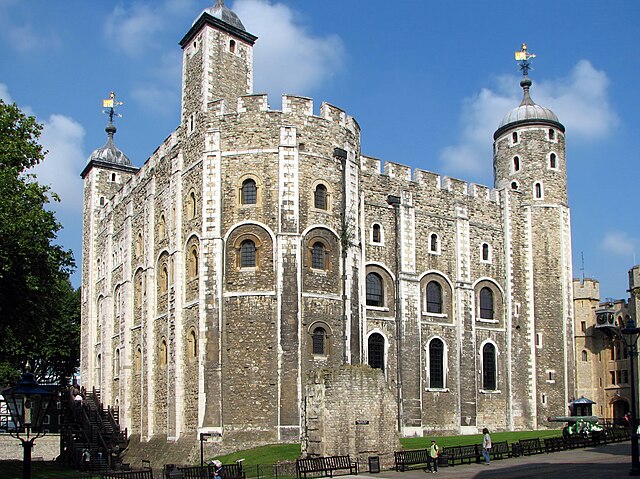
This lists free-standing structures that have at some point held the title of tallest structure in London.
Remove ads
Skylines
- The City of London skyline as viewed from St Paul's Cathedral, October 2024. The tallest building shown here is 22 Bishopsgate at 278 m, which topped out in 2019. Since its construction The Gherkin is no longer visible from this angle. There are currently four towers in this cluster that are above 200 m tall with four more approved to be constructed, 1 Undershaft at 290 m tall, 55 Bishopsgate at 269 m tall, 100 Leadenhall at 249 m tall, and 99 Bishopsgate at 240 m tall, by 2030.
- The "northern cluster" of the City of London. Some of the smaller skyscrapers shown here include: the Barbican Estate, Finsbury Tower, The Heron, Citypoint, One Crown Place, The Stage, Principal Tower and the Broadgate Tower. Also shown in the distance on the far left are 250 City Road and Lexicon Tower in the London Borough of Islington. Also approved for this cluster is the 154 m-tall (505 ft) 2–3 Finsbury Avenue and the 156 m-tall (512 ft) 13–14 Appold Street
- The Canary Wharf and Isle of Dogs business district as viewed from Blythe Hill Fields, London Borough of Lewisham, May 2021. The tallest building in this cluster is One Canada Square with the pyramid-shaped roof which was completed in 1991 and stands at 235 m. There are seven towers in this cluster that are at least 200 m tall with more planned and under construction. However, due to the proximity of London City Airport it is unlikely that any will exceed the height of One Canada Square
- The skyline of Southwark, prominently featuring The Shard. Completed in 2012 at London Bridge, it is London's tallest building at 309.6 m. Shown here in December 2019 with Guy's Hospital to the right. Two more prominent high-rises will soon join the cluster: Chapter London Bridge a 133 m building that topped out in 2024, and Edge London Bridge at 109 m, now under construction.
- The emerging South Bank cluster as viewed from St Paul's Cathedral, October 2022. The two tallest towers here are One Blackfriars which was completed in 2018 at 163 m and the South Bank Tower that was originally constructed in 1972 at 111 m but was given an 11-storey height increase in 2017 to bring it up to 150 m. There are several more towers planned for this cluster ranging from between 100 m and 178.5 m tall. There is also an emerging cluster at Elephant and Castle shown on the far left which includes notably, Strata SE1 and another emerging cluster in the distance on the right at Vauxhall/Nine Elms
- The emerging cluster at Vauxhall and Nine Elms, March 2024. There are currently five towers in this cluster that are between 160 m and 200 m tall: One Nine Elms City Tower (200m), St George Wharf Tower (181m), One Thames City No. 8 (177m), Aykon London One (168m) and One Nine Elms River Tower (161m). Within five years there will be seven towers in this cluster with heights between 160 m and 200 m
- Looking towards the West End from St Paul's Cathedral, October 2022. Shown here from left to right are Centre Point, completed in 1966, the BT Tower, completed in 1964 and Euston Tower, completed in 1970. These are all considered among the first "skyscrapers" in London. Also seen in the far distance is the 184 m-tall (604 ft) One West Point Tower 1 in North Acton, which was completed in 2022 and where there will be an emerging cluster in the years to come
- The emerging cluster in Croydon town centre which includes Saffron Square (134m), Queen's Quarter building 1 (114 m) and 101 George Street (135.6 m). Under construction is the now complete College Road Tower (150 m)
- The emerging cluster in Lewisham also known as Lewisham Gateway, and first Borough of Sanctuary,[513] which includes 209 Connington Road Tower at 117 m tall which is the white building in the centre and Lewisham Exchange at 105 m tall to the left of it. All of the high-rises shown in this picture are residential with the exception of the grey building shown in the immediate right foreground which was formerly the London offices of Citigroup until they relocated to 25 Canada Square at Canary Wharf in 2001
- The emerging cluster in Stratford in April 2023 as viewed from Greenwich Peninsula. Stratford has been undergoing regeneration, associated with the 2012 Summer Olympics, which largely took place in Queen Elizabeth Olympic Park to the west of the cluster. Seen on the left is 150 High Street at a height of 135 m. The tallest building in the cluster, Manhattan Loft Gardens at 143 m, is seen at the back.
Remove ads
See also
Notes
References
External links
Wikiwand - on
Seamless Wikipedia browsing. On steroids.
Remove ads





